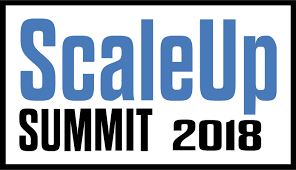 Was there another lesson to be learned from The 20 Mile March Discipline – Great by Choice?
Was there another lesson to be learned from The 20 Mile March Discipline – Great by Choice?
Morten Hansen, co-author of Great by Choice with Jim Collins, found another lesson in his book, Great At Work, sharing it with us at the Denver ScaleUp Summit.
Do Less, Then Obsess Example
Ronald Amundsen’s team of 19 won the march to be first to the South Pole against Robert Falcon Scott.
Scott had more men, more money, more options. Yet Amundsen beat Scott’s team by a full 34 days, and made it back alive. Scott’s entire team died on the journey back less than 25 miles from their next food depot.
Verne Harnish, author of ScalingUp often preaches the practice of, “Less is More.” Nowhere is this more evident than in this example.
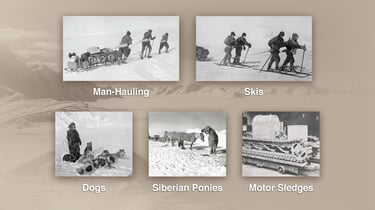 Scott chose five different avenues of transportation, reasoning, if one failed he had backup.
Scott chose five different avenues of transportation, reasoning, if one failed he had backup.
Amundsen, determined Greenland sled dogs were the best performing transportation to use based on his previous experience in frigid conditions. While Scott was too busy to get the best Siberian Ponies for his expedition, sending his aid (a dog-sled expert no less) to Russia to make this purchase decision, Amundsen found and relentlessly pursued the best dogs and sled-leader to take on his expedition.
While Scott was busy coordinating his 5 transportation options, making sure the slowest started earliest, Amundsen was gaining time, trekking faster than Scott’s coordinated efforts could traverse the same conditions.
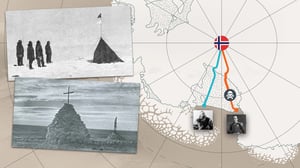 During the first eight weeks, he and his small team of four experts, with four sledges and 52 superior dogs, averaged 15 miles per day against Scott’s 11. Amundsen gained at least four miles on Scott every day on average.
During the first eight weeks, he and his small team of four experts, with four sledges and 52 superior dogs, averaged 15 miles per day against Scott’s 11. Amundsen gained at least four miles on Scott every day on average.
Results of Do Less, Then Obsess
Hansen’s 5 year research of over 5000 men, women, leaders, and staff discovered, “Do Less, then Obsess” is the greatest performance enhancer of the Seven Work Smart principles. Visit DO LESS, THEN OBSESS – HOW TO BE GREAT AT WORK to discover how to improve work performance at your business. These principles are critical to leadership, and staff.
 People who were average at other practices but mastered “Do less, then obsess” placed 25 percentage points higher in performance rankings than those who didn’t embrace this practice.
People who were average at other practices but mastered “Do less, then obsess” placed 25 percentage points higher in performance rankings than those who didn’t embrace this practice.
The “Do less, then obsess” practice affects performance more than any other practice.
The term “focus” consists of two activities: choosing a few priorities, and then dedicating your efforts toward excelling at them.
Many people prioritize a few items at work, but they don’t obsess—they simply do less.
That’s a mistake.
How to Do Less, then Obsess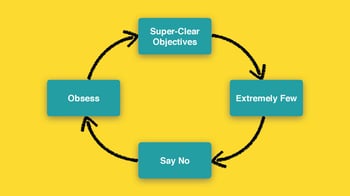
Hansen outlined four rules to key in on this principle to “Do Less, then Obsess.”
- Super-Clear Objectives: As I’ve shared in many blogs, this is simply using SMART Goals to be clear on your objective. For businesses and for yourself, consider establishing a One Thing Priority. Clarity’s First Step – Determining Your One Thing is a good reminder of this principle, as would be reading Gary Keller’s The ONE Thing: The Surprisingly Simple Truth Behind Extraordinary Results.
- Extremely Few: Pick just a few, or as noted above, ONE. When Steve Jobs decided to create the iPhone , Apple was working on the iPad. Having made the decision the iPhone was Apple’s #1 Priority, they put the iPad on the shelf until the iPhone was done. Pick what your best at, and do those things that play to your strengths!
- Say No: This means your are clear on your focus. Ask yourself, why am I (or we) tackling this? How many things have you said no to? Make a list each week of the things you say no to. Subtract and Simplify. Create, as we’ve suggested , a STOP DOING LIST!
- Obsess: This means having fanatical attention to detail. Be the best, do less. Put your focus on learning and doing everything you can at what you are focused on. Amundsen didn’t win just because he picked dogs. He won because once he had chosen dogs, he applied huge amounts of effort to perfecting that single method of transporting the sledges. Had he shown up with just “good enough” dogs and drivers, he wouldn’t have traveled so fast each day, and he might have lost the race.
To learn more about Why Some People Perform Better Than Others, watch this 3 minute clip from Morten Hansen from NBC news.
Growth demands Strategic Discipline.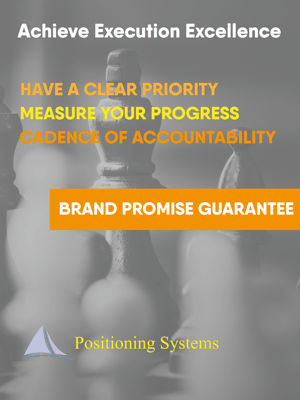
Positioning Systems is obsessively driven to improve your business and your teams execution at work. 3 Strategic Disciplines: Priority, Metrics and Meeting Rhythms help your business dramatically improve your forecasting, individual and team performance to create alignment. It empowers your team to achieve accelerated growth.
As an Execution Decision, Strategic Discipline increases your businesses Profitability.
Positioning Systems helps your business achieve these outcomes on the Four most Important Decisions your business faces:
|
DECISION |
RESULT/OUTCOME |
|
PEOPLE |
|
|
STRATEGY |
|
|
EXECUTION |
|
|
CASH |
|
We help your business achieve Execution Excellence.
Positioning Systems helps mid-sized ($5M - $250M) business Scale-UP. We align your business to focus on Your One Thing! To achieve growth, you need to evolve in today’s rapidly changing economic environment. Have you been avoiding a conversation on how you can successfully grow your business? Contact dwick@positioningsystems.com to Scale Up your business! Take our Four Decisions Needs Assessment to discover how your business measures against other Scaled Up companies. We’ll contact you.
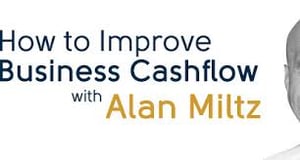 Next Blog – Power of One
Next Blog – Power of One
How do you fix Cash Flow in your business? Alan Miltz, an authority on Cash Flow, shared Revenue is Vanity, Profit is Sanity, Cash is King. We‘ll share his seven levers to produce more cash in your business next blog.






.jpeg?width=150&height=135&name=Hand%20with%20marker%20writing%20the%20question%20Whats%20Next_%20(1).jpeg)

